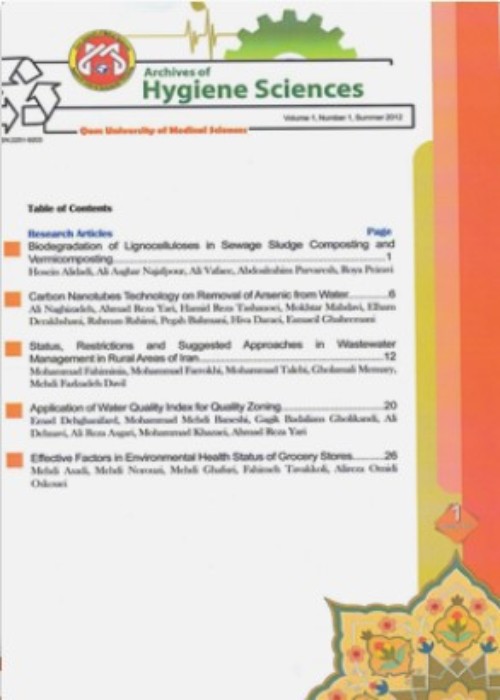Modelling of Disinfection by-products formation via UV irradiation of the water from Tajan River (source water for Sari drinking water, Iran)
Author(s):
Abstract:
Background and Aims
of the Study Irradiation with ultraviolet light (UV) is used for the disinfection of bacterial contaminants in the production of potable water. The main objective of the study was to investigate and model Disinfection By-Products (DBPs) formation due to the UV Irradiation of the Tajan River water under different Irradiation conditions.Materials and Methods
Water samples were collected throughout September 2011 to August 2013. Transportation of the sample to the laboratory was done on ice in a cooler, and physiochemical analysis was conducted immediately within one day. Dissolved organic carbon (DOC) was determined by a TOC analyzer. Irradiation experiments were conducted in a series of 25 mL glass serum bottles with Teflon septa. The present study adopts an orthogonal design. The design involved irradiation with UV at a UV/DOC ratio of 0.5–3.0 and incubating (headspace-free storage) for 5–25 sec. A 1 mM phosphate buffer maintained the pH at 6, 7, or 8 respectively, and an incubator maintained the temperature (Temp) at 15, 20, or 25 °C respectively. The development of empirical models for DBPs formation used a multivariate regression procedure (stepwise) which applied the SPSS System for Windows (Version 16.0).Results
The results showed that the total DBPs formation ranged between 12.3 and 67.4 mg/l and that control of the levels was primarily due to the reaction time and the dissolved organic carbon level (DOC) in the water.Conclusions
Reaction time and level of DOC concentrations in water exerted a dominant influence on the formation of DBPs during the UV irradiation of water from the Tajan River. The relationships between the measured and predicted values were satisfactory with R2 values ranging from 0.89 (for Octanal)–0.92 (for Formaldehydes). The DOC level in water is the key factor in controlling DBPs formation.Keywords:
Disinfection , Ultraviolet radiation , Modelling , Drinking water , analysis , Iran , Sari
Language:
English
Published:
Archives of Hygiene Sciences, Volume:2 Issue: 4, Autumn 2013
Page:
135
https://magiran.com/p1238314


